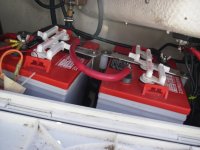Well, Bob, you make some interesting points. Still, I think that golf cart batteries are the answer to anchoring power, as I mention below.
First, yes, 2 ea 31 RV batteries have more rated power. 2 ea 31's aren't going to fit inside a C-Dory 25 lazerette. And RV batteries will not last as long as golf cart batteries, cause they aren't built the same. That's why you used and I use golf cart batteries. When we lived on board, RV batteries only lasted about 10 mos, even at 50% discharge. I checked and that's what they're rated for. Switched to golf carts and they lasted until I sold the boat. Still, your choice. Golf cart batteries are 1 1/4" taller.
I counted the wires off the battery and I was disgusted. But each needs direct access to the battery and are separately fused. Count them:
1. Power to the main switch, DC boat power.
2. Power to the inverter switch, DC inverter power. Don't mix the 2..
3. Power to the bilge pump.
4. Voltmeter line.
5. To the Wallis, factory installed.
I want to put in battery terminal strips, and I will do this after a few other tasks. Only have 1 return line though.
Sorry about the uncovered terminals. And those batteries are using the factory battery hold downs, suitably reworked. They're not going anywhere, even upside down. To make everybody happy, I use 2 wingnuts and 2 hex nuts. The Supreme Court says we can't discriminate.
You know, I forgot about the DC output of the Honda gen. You're right, that's only 8 amps. Since the Honda puts out 800 watts on the AC side, I assumed that everyone would recognize that i use a regular battery charger, connecting the gen through the shore power input. I lost the DC cable years ago.
And, Kevin, Journey On has the same water heater. Defender sells a 240 VAC heating element. If you install this in the heater, the 1000i gen will heat the water at a 400 watt rate. It'll take longer but you can do this whilst you charge the batteries (after the initial surge is over.)
Boris

